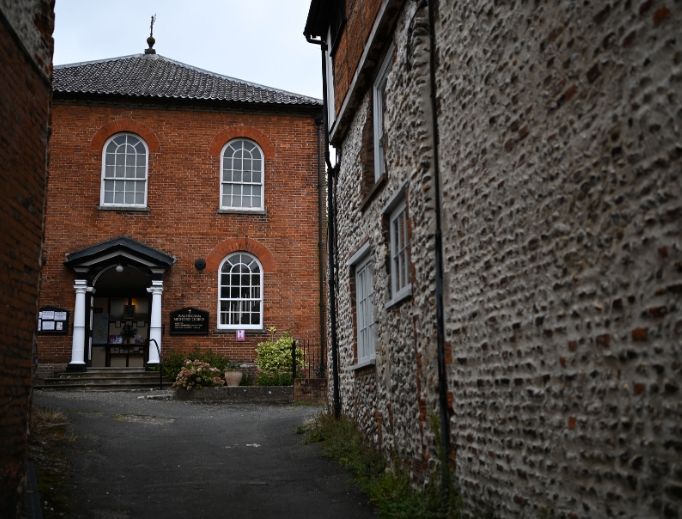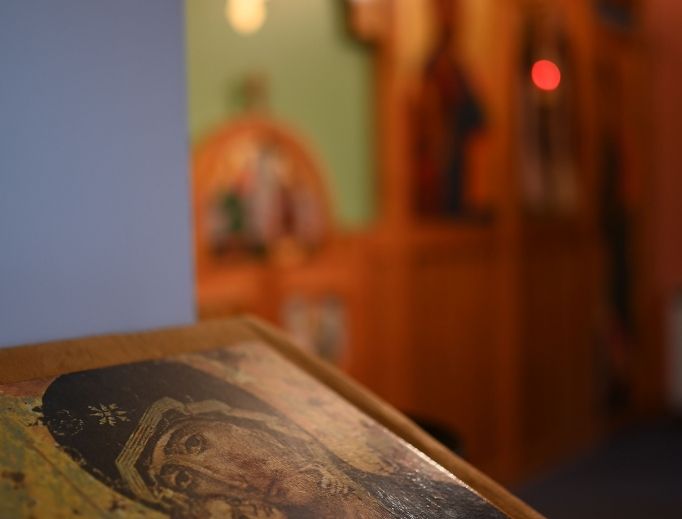Walsingham: Place of Pilgrimage Is Catholic and Ecumenical
Five centuries after its destruction, the English Marian shrine is drawing Christians of different denominations.

Walsingham is unique as a Marian place of pilgrimage in that it has both a Catholic and Anglican shrine. In fact, the 20th-century restoration of the medieval shrine that was destroyed during the English Reformation is as much due to the work of Anglicans as it is to English Catholics.
In addition to an Anglican and Catholic presence, there are also now two Russian Orthodox churches nearby, as well as one of the oldest Methodist churches in the country.
The presence of so many Christian denominations at Walsingham raises the question: What does each tradition understand of the Marian dimension of this ancient place of Christian pilgrimage?
Method of Unity?
There has been a Methodist presence at Walsingham since the beginning of the movement started by John Wesley in the 18th century. In fact, Wesley visited Walsingham in 1781. His journal noted how he preached in the village before going to the ruins of both the Franciscan friary and the Augustinian priory. “Had there been a grain of virtue or public spirit in Henry the Eighth,” wrote the founder of Methodism, “these noble buildings need not have run to ruin.” The next year a Methodist chapel was built in Walsingham before the present one was erected in 1793-4. This remains the oldest purpose-built (specifically built to be used as a church) Methodist chapel in East Anglia still in use.
Speaking to the Register this past fall, Rosemary Wakelin, a member of the Methodist congregation at Walsingham, said, “Like most of Walsingham Methodists (of whom there are very few), we respect the shrine and the pilgrims who come but don’t join in much with events surrounding it, though I have joined in a Stations of the Cross.” She told of her interest in the history of the shrine while noting that she could not “share the veneration and rituals that surround it.” Nevertheless, she went on: “I have, like all Methodists, always loved and honored Mary as the mother of Jesus and for her own amazing trust in God and willingness to obey. I wish we knew more about her. Her dedicated love for, and loyalty to, Jesus to the agonizing end remains an inspiration, and I long to meet her!”
Wakelin is always pleased to welcome pilgrims, of whatever denomination, to the local Methodist church; she feels, however, that Walsingham is “mainly a Roman Catholic and High Anglican enterprise, without much ecumenical participation. It will always be difficult while we still can’t gather round the same table, and Protestants will always have a problem with statues and some Roman Catholics doctrines.” But she concluded with a hope: “I have been delighted to share in ecumenical services. … I long for the day when we can all be one.”

Orthodox Station
A more recent presence in Walsingham is that of the Eastern Orthodox. When the Anglican shrine church was built in the 1930s, it included a small Russian Orthodox chapel. During the Second World War, many prisoners of war from Eastern Europe were held in camps nearby. These prisoners used this Orthodox chapel for their worship. When the war ended and the prisoners left, regular Orthodox services ceased at the shrine. However, in 1966, the Russian Orthodox Church bought Walsingham’s disused railway station, converting the building into a church. Today, complete with onion dome topped by a cross, it is the Russian Orthodox Chapel of St. Seraphim, Little Walsingham. The Russian Orthodox presence increased when, in 1986, the Church of the Holy Transfiguration in Great Walsingham was established. There are two villages literally beside each other, one Little Walsingham and the other Great Walsingham. Little Walsingham is where the ancient shrine was. There are two Russian Orthodox churches, with one in each village.
Father Christopher Knight is the Orthodox priest in charge of this church. He spoke to the Register last fall and began by explaining how the Church of the Holy Transfiguration has a regular Sunday liturgy attracting around 20 people, with these numbers augmented in the summer months.
Reflecting on the ecumenical nature of Walsingham, Father Knight said: “The shrine is obviously an important sign of the history of Walsingham as a place of pilgrimage, but, to be frank, we are only rarely invited to join ecumenical events; and, in that sense, it has little impact on my local ministry.” He added, “I do wish that there was more ecumenical activity. In the 1970s there was quite a lot of ecumenical activity in Walsingham involving Bishop Christopher of Telmessos, of the Greek archdiocese in this country, who often brought groups up to the Anglican shrine. After the Anglican decision to ordain women, however, Orthodox interest [in ecumenical activity] waned, though small parish groups do still visit Walsingham from time to time.”

Anglican Use
The Anglican presence at Walsingham has traditionally been as prominent as the Catholic one, perhaps more so. The Anglican shrine is in the heart of the village and consists of a large shrine church that contains within it a replica of the Holy House, the original of which would have stood in the Augustinian priory, now a forlorn ruin. The shrine began in 1061, when Lady Richeldis de Faverches had a vision of Mary, who asked her to build a replica of the house at Nazareth where the Incarnation took place. Although Henry VIII suppressed the shrine, it began to be restored in the 20th century — and pilgrims continue to honor the Blessed Mother here, including on her feast day, Sept. 24, under the title of Our Lady of Walsingham.
This fall, an Anglican clergyman and his wife, Donald and Samantha Griffin, traveled from Dallas on pilgrimage to Walsingham. As Rev. Griffin told the Register, “We traveled all the way from Texas to Walsingham because, simply put, it’s worth traveling to. I’ve known of Walsingham for a while now as an important and ancient pilgrimage site and a place of particular significance for the Anglo-Catholic tradition in which I have been steeped.” Both he and his wife have been to Walsingham twice now. “Walsingham truly is a special place for us both,” he explained. “For me, it was the full package. I loved Walsingham both as a sacred site and as a lovely country village, with all the best that both those things have to offer. A colleague of mine calls Walsingham his ‘happy place,’ and I feel the same way. There’s just something about it! …”
“In many ways,” he added, “Walsingham is just like any other rural English village, but, for me, it’s much more than that. To use of words of T.S. Eliot in Little Gidding, Walsingham is a place ‘where prayer has been valid,’ where ‘the intersection of the timeless moment is England and nowhere.’ I have a feeling that centuries of devotion have left their mark on the place in this way.”
Samantha is in total agreement about the continuing attraction of Walsingham for the couple. She told the Register, “We returned [to Walsingham] because we both fell in love with the place. I love the setting: the rolling green hills, the great trees, the sheep and the beautiful village. It’s quiet, reflective and inspires me. I feel like I can really relax while I’m here (which is rare for me) and simply enjoy nature and the quiet pace of the church and countryside. It’s one of the few places in the world that leaves me feeling renewed.”
Samantha said the couple will definitely be returning, drawn by what the shrine offers: “Its setting and history. There’s an intriguing feeling of mystery and tradition surrounding Walsingham. It gladdens me to see a place that once fell silent become lively again.”
Initially, the Griffins visited Walsingham as a result of hearing about it in Anglo-Catholic circles in the States. “At best, Walsingham was, to me at that time, a curiosity,” recalled Rev. Griffin. “Now that I’ve been a couple of times, however, I can say that I get it. The first time I visited the Anglican shrine, my thought was, ‘I’m glad a place like this exists in the Anglican Communion.’”
“The feeling that I get from both the Anglican shrine and the Roman Catholic shrine is a feeling of comfort, of domesticity,” he added. “In fact, the whole place feels like home. And I think that’s what devotion to Our Lady of Walsingham is all about. The Holy House is nothing more (nor less) than a representation of the Holy Family’s home. It represents an invitation to become a part of that family, to make your home with the Word who became flesh and made his home with us, and to experience the tender love of Jesus that binds us together with Our Lady and all the saints.”
While in no way attempting to downplay the very real differences between the Anglican Communion and the Catholic Church, and indeed the Orthodox Church, Rev. Griffin said, “While I want to avoid a cheap ecumenism that papers over all our differences too easily, I think the homeliness of Walsingham shows us that we are all family. We may not always agree, and we may even fight. But, at the end of the day, we can all find a home under the same roof with Jesus, Mary and Joseph.”
K.V. Turley is the Register’s U.K. correspondent.
- Keywords:
- christian unity week
- k.v. turley
- walsingham

















